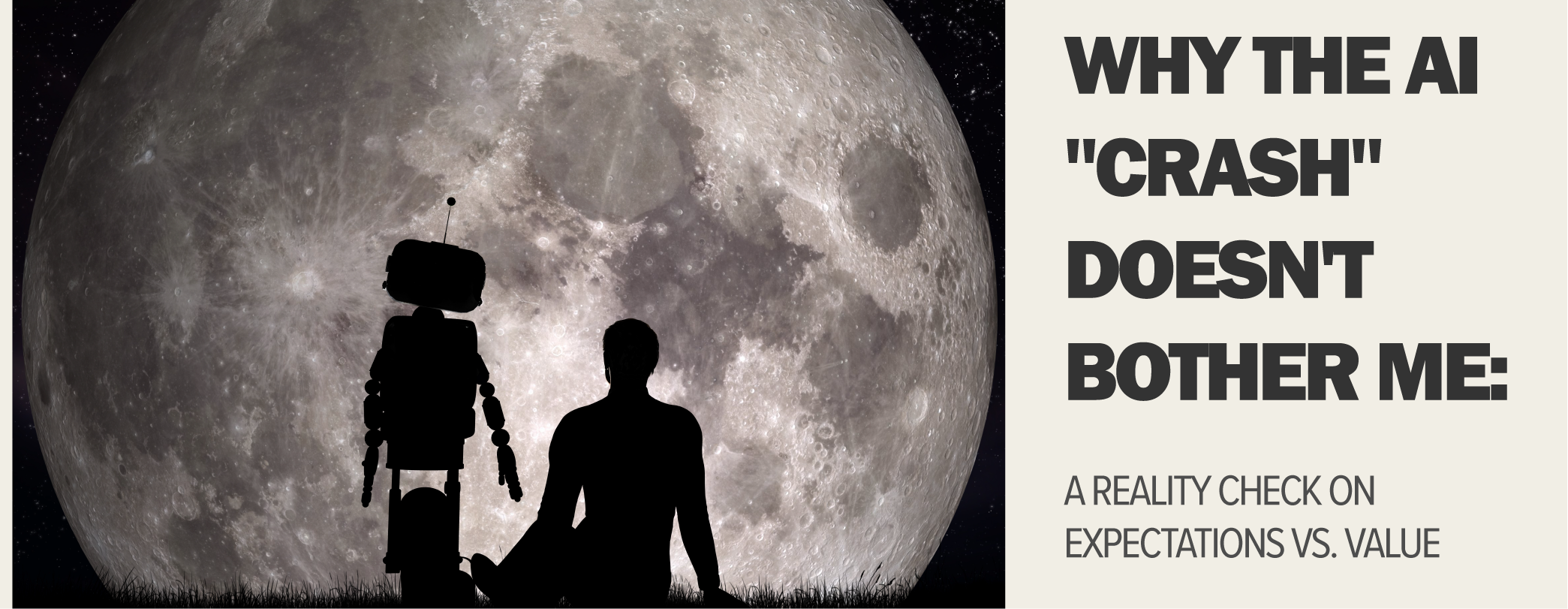The LA Times declares the AI bubble over. GPT-5 disappoints. Investors panic. Meanwhile, we're having the best year ever at InfluxMD. Here's why the "crash" might be exactly what we needed.
Michael Hiltzik's recent LA Times piece "Say farewell to the AI bubble, and get ready for the crash" landed with the force of a reality check. OpenAI's GPT-5 launch flopped. Academic experts are calling out the hype machine. Hundreds of billions in investments suddenly look shaky. The consensus seems clear: the AI dream is over.
Except it's not. And frankly, I'm not bothered by this so-called crash at all.
The Expectation Trap
Here's the thing that's been driving me crazy about AI discourse for the past two years: we've been setting completely unrealistic expectations.
The hype cycle promised us artificial general intelligence, consciousness, and systems that would rapidly surpass human capability across all domains. But here's the reality check: we're still dealing with sophisticated pattern matching and prediction systems, not thinking machines.
Yes, AI can exceed human performance in specific, narrow domains—just like calculators surpass us at arithmetic. But the leap from "better at specific tasks" to "superhuman general intelligence" is where the magical thinking begins.
The "exponential growth toward AGI" narrative that Alex Hanna and Emily Bender critique in their book "The AI Con" was always more venture capital storytelling than scientific roadmap. Yes, we hit walls. That's what happens when hype meets physics, when marketing meets engineering reality, when venture capital meets the actual complexity of intelligence.
What AI Actually Does Well
But here's what the bubble-burst crowd is missing: AI doesn't need to be superhuman to be transformative.
At InfluxMD, we've built our medical CRM around AI capabilities, and this technology has been nothing short of revolutionary for our users. Not because it's achieved artificial general intelligence—it hasn't—but because it's exceptionally good at the specific tasks our customers actually need.
Our AI helps physicians draft patient communications, summarize staff intake notes, and navigate sales and marketing strategies. It doesn't need to cure cancer or solve consciousness. It just needs to save Dr. Johnson in Spokane three hours a week on administrative tasks so she can spend more time with patients.
That's not superhuman intelligence. That's appropriate intelligence applied to real problems.
The Difference Between Hype and Utility
The investors who poured hundreds of billions into AI companies expecting magic are discovering what those of us building practical applications already knew: the value isn't in the hype, it's in the utility.
While OpenAI was promising PhD-level reasoning and getting venture capitalists excited about artificial general intelligence, we were focused on something much more modest and infinitely more useful: helping healthcare professionals do their jobs better.
GPT-5's failure to deliver on impossible promises doesn't affect us because we never needed impossible promises. We needed a technology that could understand medical terminology, generate coherent text, and integrate with existing workflows. The current generation of AI does all of that remarkably well.
We're Not in a Bubble—We're in a Golden Age
This is where I part ways with the doom-and-gloom analysts. Yes, there's a bubble in AI valuations and investor expectations. But there's no bubble in AI capability when properly applied.
We're living through a period of unprecedented technological capability. For the first time in history, small companies like InfluxMD can deploy sophisticated language understanding that would have required teams of computational linguists and decades of development just ten years ago.
The fact that this technology can't pass a Turing test or achieve consciousness is irrelevant. What matters is that it can help a family practice physician in rural Montana manage patient records more efficiently, or assist a specialist in Seattle with prior authorization paperwork.
The Practical AI Revolution
The real AI revolution isn't happening in the boardrooms where executives promise superhuman intelligence. It's happening in the exam rooms where doctors are spending less time on documentation and more time with patients. It's in the small business offices where entrepreneurs can now afford capabilities that were previously exclusive to large enterprises.
This practical revolution doesn't require exponential growth curves or trillion-dollar valuations. It just requires technology that works reliably for specific, well-defined problems.
Lessons from the Reality Check
The GPT-5 disappointment and the broader AI bubble burst teach us several important lessons:
First, expectations matter more than capabilities. If you promise the moon and deliver a really good flashlight, people will be disappointed. If you promise a really good flashlight and deliver exactly that, people will be delighted.
Second, utility trumps novelty. Our customers don't care if our AI can write poetry or solve philosophical puzzles. They care if it can help them run their practices more efficiently.
Third, sustainable businesses are built on solving real problems, not chasing headlines. While the AI unicorns were burning through venture capital trying to achieve artificial general intelligence, we were building profitable solutions for specific industries with actual paying customers.
What Comes Next
The AI bubble burst might be the best thing that could happen to the industry. It will force companies to focus on real value instead of theoretical capabilities. It will separate the businesses building useful tools from those building PowerPoint presentations for investors.
For companies like InfluxMD and our users, this reality check changes nothing. We were never betting on superhuman AI. We were betting on human-level AI applied to specific problems where automation adds genuine value.
The technology that exists today—imperfect, limited, decidedly non-superhuman—is still the most powerful set of tools ever made available to small and medium businesses. The fact that it can't achieve consciousness or solve every problem doesn't diminish its revolutionary impact on day-to-day operations.
The Bottom Line
Sorry, investors. Your trillion-dollar AGI fantasies were always unrealistic. But the rest of us? We're doing just fine.
The AI crash isn't the end of the AI revolution—it's the beginning of the useful AI era. And frankly, that's exactly what we needed.

